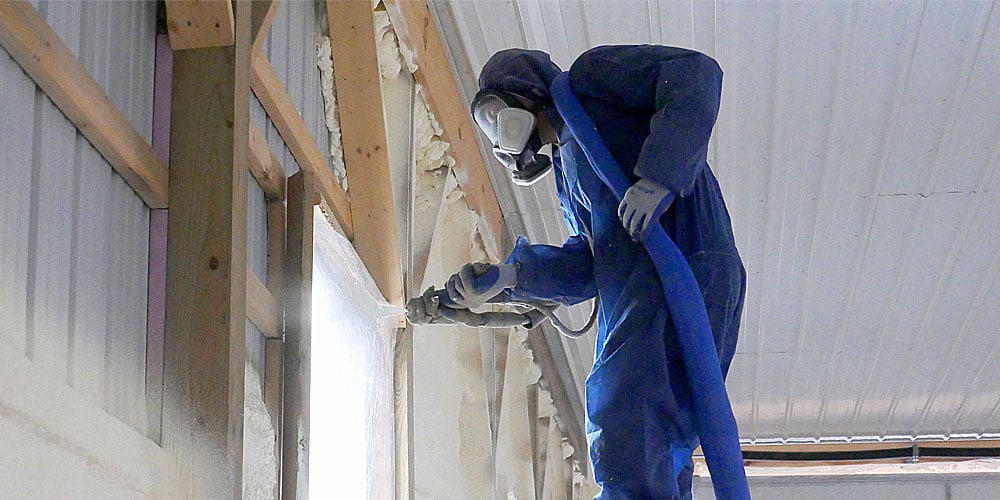The Best Spray Foam Insulation for Your Pole Barn: Open Cell, Closed Cell, or Both
open cell spray foam insulation | spray foam insulation | closed cell spray foam insulation | foam university


When it comes to insulating your pole barn or commercial building, the decision between open cell and closed cell spray foam can be a bit of a puzzle.
Both types have their merits, but understanding their distinct advantages can help you make the best choice for your specific needs. But there are instances when both spray foam materials are the best choice.
Let’s break down what you need to know about both to decide if one or the other, or even both are the best spray foam pole barn insulation for your project.
Is Pole Barn Spray Foam Closed Cell or Open?
Ultimately, the choice between open cell and closed cell spray foam for your pole barn depends on several factors:
- Budget: If cost is a significant consideration, open cell foam’s affordability makes it an attractive option for large areas like ceilings.
- Location and Exposure: For walls that are more prone to physical damage or exposure, closed cell foam’s durability is beneficial.
- Insulation Needs: Both open and closed cell foams offer excellent thermal resistance and air sealing capabilities.
This was the quick answer, so let’s take a deep dive into pole barn spray foam insulation.
Closed Cell Spray Foam in a Pole Barn: The Durable Choice for Walls
When it comes to insulating the walls of your pole barn, the choice of material needs to hold up to whatever you throw at it, and in this sense, I mean literally.
Closed cell spray foam insulation stands out as a top choice, renowned for its exceptional toughness and durability. In a pole barn where the walls are exposed to various elements and potential impacts, the resilience of closed cell spray foam is invaluable.
Let’s get into why closed cell spray foam in your pole barn might be the best option.
Why Choose Closed Cell for Pole Barn Walls?
Closed cell spray foam is a widely favored option for pole barn walls, thanks to its remarkable toughness and durability.
This type of insulation is specifically engineered to withstand prolonged exposure and physical impacts, making it an ideal choice for walls that are susceptible to bumps and nicks.
The exceptional resilience of closed cell spray foam becomes even more crucial if your pole barn walls are left exposed to the elements, ensuring long-lasting protection and structural integrity.
Durability and Thermal Resistance of Closed Cell Spray Foam
Closed cell foam, known for its durable and resilient properties, offers the advantage of long-lasting protection without the hassle of frequent touch-ups or repairs.
Its exceptional thermal resistance further enhances its appeal as an insulator, ensuring optimal comfort in your pole barn regardless of the season. With closed cell foam, you can enjoy peace of mind knowing that your structure is not only well-protected but also optimized for insulation efficiency.
Closed cell spray foam creates an air seal that just isn’t possible with traditional insulation like fiberglass or cellulose.
Open Cell Spray Foam: A Cost-Effective Option for Ceilings
When considering insulation options for your pole barn’s ceiling, roof deck, or wall cavities you plan to finish, open cell spray foam emerges as a great choice.
Some pole barn owners actually pair up open cell on the ceiling and closed cell on the walls to get the best of both worlds.
Open cell spray foam is a cost-effective option, especially if you’re covering such a large area as a pole barn roof deck.
In addition to open cell’s lower cost, it’s suitability for pole barn ceilings because it’s not exposed to physical damage from tools or machinery.
Another added bonus – open cell offers great thermal resistance and an air seal, just like closed cell spray foam.
Let’s dive into all of the reasons open cell is another great option for your pole barn insulation.
The Advantages of Open Cell on Pole Barn Ceilings
While closed cell foam is a great fit for walls, open cell spray foam offers significant benefits when used on pole barn ceilings or roof decks.
Not only is it a cost-effective option, but it can be a real game changer if something were to happen and your roof sprung a leak.
If there is a water leak in the roof of your pole barn, open cell spray foam will allow that water to move through it. You might be thinking that is the last thing you want, but in reality, it’s actually a good thing.
Closed cell spray foam doesn’t allow water to move through it, meaning that water is either going to just sit on the roof or pool somewhere else.
Cost-Effectiveness of Open Cell Spray Foam in a Pole Barn
Open cell foam is often considered a more affordable option compared to closed cell foam.
This cost advantage becomes particularly noticeable when applied to larger areas, such as a pole barn roof, where the cumulative savings can accumulate rapidly. By opting for open cell foam, not only can you enjoy the economic benefits, but also ensure effective insulation for your structure.
Thermal Resistance and Air Sealing Properties of Open Cell Spray Foam
Despite some misconceptions, open cell spray foam offers strong thermal resistance, making it highly effective in maintaining temperature control.
Its air sealing properties are comparable to those of closed cell foam, ensuring a well-insulated environment. Many times in pole barns, people are looking to maintain a constant temperature and to create a controlled environment.
Both open cell and closed cell spray foam are able to help regulate the temperature of the building.
Addressing Moisture Penetration Concerns
Both open cell and closed cell spray foam have unique properties and performance characteristics when it comes to their interaction with moisture.
This distinction becomes critical when choosing the right insulation for your pole barn. At the heart of this decision is the difference between open cell and closed cell is how they handle moisture.
Here’s what you need to know.
Open Cell Vs. Closed Cell in Moisture Scenarios
Closed cell foam is well-known for its excellent moisture resistance due to its dense and compact structure.
This feature makes it a great option for environments where moisture exposure is a big concern, providing strong protection against water penetration and related damage.
On the other hand, open cell foam, with its lighter and more permeable structure, offers a different profile. While it may not offer the same level of moisture resistance as closed cell foam, it can still be a practical choice for many applications. Ultimately, the suitability of open cell foam depends on specific environmental conditions and the intended use of the pole barn or structure in question.
With all of this being said, it’s important to remember that in some areas, you’re not going to want the foam to prevent leaks, like from the roof. This is why we recommend closed cell spray foam for the exposed walls and open cell for the ceiling.
Tailoring Pole Barn Insulation to Your Needs
By understanding the unique advantages of open cell and closed cell spray foam, you can tailor your insulation choice to best suit the needs of your pole barn.
Whether it’s the cost-effectiveness and sufficient protection of open cell foam for ceilings or the robustness of closed cell foam for walls, or maybe both, the right insulation will enhance the energy efficiency and durability of your structure.
For more insights into insulating pole barns with spray foam, visit our Learning Center. There, you'll find a wealth of resources, including videos, articles, and blogs, all designed to deepen your understanding of foam insulation and its applications in pole barns.
Remember, building is a science, and choosing the right insulation is a key part of that science.
Related Articles
Installing Spray Foam Insulation in Metal Buildings When It’s Cold
Benefits of Spray Foam Insulation on Commercial Garage Doors
Why Closed Cell Spray Foam Insulation is a Popular Choice for Homeowners
About Eric Garcia
Eric brings his knowledge and training in building science, training in spray and injection foams from the manufacturers, more than eight years installing foam insulation, as well as selling and managing in the foam insulation industry. He is also BPI and Dale Carnegie certified and has taken several building science courses, including air sealing and building envelope. Eric is the Professor of Foam on our educational YouTube series Foam University. Even when Eric is off he is usually still “working” or thinking about work, but when he can get away he enjoys camping, hiking, hunting, and woodworking.


